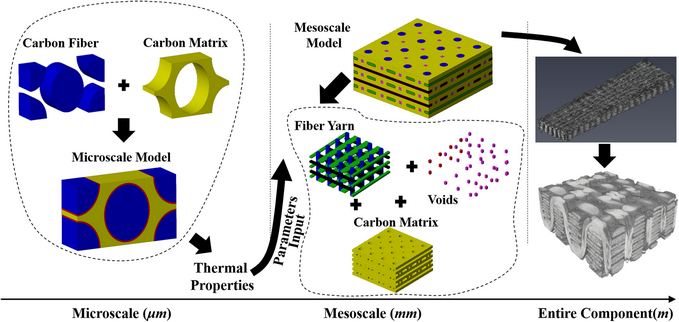Crossref Citations
This article has been cited by the following publications. This list is generated based on data provided by
Crossref.
Xu, Chang
Sun, Zhihong
and
Shao, Guowei
2021.
Prediction of Effective Thermal Conductivities of Four-Directional Carbon/Carbon Composites by Unit Cells with Different Sizes.
Applied Sciences,
Vol. 11,
Issue. 3,
p.
1171.
Xu, Chang
Dou, Jinzhen
Li, Xin
Shao, Guowei
and
Sun, Zhihong
2022.
Numerical study on thermal conductivities of spread tow woven pierced composites.
Textile Research Journal,
Vol. 92,
Issue. 23-24,
p.
4834.
Liu, Yang
Shan, Zhongde
Lv, Zhigang
Liu, Feng
Sun, Zheng
and
Li, Jiahua
2022.
Systematic deformation model of a square guide bar array in a flexible oriented 3D woven process.
Composite Structures,
Vol. 280,
Issue. ,
p.
114849.
Liu, Yang
Shan, Zhongde
Liu, Feng
and
Sun, Zheng
2023.
Out‐of‐plane compression properties and failure mechanism of gradient 3D woven composites.
Polymer Composites,
Vol. 44,
Issue. 9,
p.
5746.
Mi, Zhaoguo
Chen, Zhenhua
Yang, Weihua
and
Nawab, Yasir
2023.
Experimental and Numerical Analysis of the Thermal Conductivity of SiCf/SiC Composites.
Advances in Materials Science and Engineering,
Vol. 2023,
Issue. ,
p.
1.
Li, Biao
Huang, Dong
Li, Tongqi
Ye, Chong
Zhang, Ningyuan
Zhou, Xingming
Fan, Zhen
Liao, Gen
Han, Fei
Liu, Hongbo
and
Liu, Jinshui
2023.
The positive role of mesophase-pitch-based carbon fibers in enhancing thermal response behavior in Carbon/Carbon composites.
Materials Characterization,
Vol. 196,
Issue. ,
p.
112630.
Zhao, Xiaoyu
Guo, Fei
Li, Beibei
Wang, Guannan
and
Ye, Jinrui
2023.
Multiscale numerical modeling for thermal behavior of plain-woven composites with interfacial and internal defects.
International Journal of Heat and Mass Transfer,
Vol. 202,
Issue. ,
p.
123711.
Liu, Yang
Shan, Zhongde
Lv, Zhigang
Sun, Zheng
and
Du, Wudi
2023.
Research on the thermal conductivity and ablation performance of gradient 3D woven carbon/carbon composite.
Ceramics International,
Vol. 49,
Issue. 11,
p.
16809.
Huang, Hao
Shan, Zhongde
Liu, Jianhua
Sun, Zheng
Guo, Zitong
Gong, Hao
Xia, Huanxiong
Jin, Peng
and
Chen, Chaozhong
2023.
A unified trans-scale mechanical properties prediction method of 3D composites with void defects.
Composite Structures,
Vol. 306,
Issue. ,
p.
116574.
Xu, Chang
Shao, Guowei
Li, Bin
and
Sun, Zhihong
2023.
Research into the thermal expansion behavior of spread tow woven pierced carbon/carbon composites at high temperature.
Textile Research Journal,
Vol. 93,
Issue. 19-20,
p.
4600.
Hu, Peili
Shan, Zhongde
Zang, Yong
Liu, Feng
Sun, Zheng
and
Wu, Xiaochuan
2024.
High‐Temperature Thermal Conductivity of Fiber Hybrid Ceramic Matrix Composites with Different Modes.
Advanced Engineering Materials,
Vol. 26,
Issue. 10,
Sun, Zheng
Shan, Zhongde
Huang, Hao
Wang, Dong
Wang, Wang
Liu, Jiale
Tan, Chenchen
and
Chen, Chaozhong
2024.
Multi-scale Modeling and Finite Element Analyses of Thermal Conductivity of 3D C/SiC Composites Fabricating by Flexible-Oriented Woven Process.
Chinese Journal of Mechanical Engineering,
Vol. 37,
Issue. 1,
Liu, Yang
Shan, Zhongde
Liu, Feng
and
Sun, Zheng
2024.
Optimization control of guide bar array deformation in flexible‐oriented 3D woven process.
Polymer Composites,
Vol. 45,
Issue. 6,
p.
5386.
Tan, Chenchen
Huang, Hao
Sun, Zheng
Shan, Zhongde
Guo, Zitong
Guo, Kehong
Bian, Jinshuai
and
Wang, Weihao
2025.
A comparative study of tensile fatigue life in various flexible-oriented three-dimensional woven process structures based on finite element models.
Composite Structures,
Vol. 352,
Issue. ,
p.
118680.
Wang, Weihao
Huang, Hao
Shan, Xuehao
Shan, Zhongde
Sun, Zheng
Guo, Zitong
and
Tan, Chenchen
2025.
A bending test and performance prediction study of large deformation braiding-needling composite preform.
Composites Part A: Applied Science and Manufacturing,
Vol. 194,
Issue. ,
p.
108851.
Du, Wudi
Shan, Zhongde
Liu, Feng
Wu, Xiaochuan
Chen, Zhe
and
Zou, Guisheng
2025.
Research on ultrasonic-assisted vibration multi-cycle compaction method of flexible guided 3D weaving.
Ultrasonics,
Vol. 145,
Issue. ,
p.
107461.
Zhou, Zhengxi
Sun, Zheng
Shan, Zhongde
Guo, Kehong
Yang, Tianzheng
Yang, Haoda
Deng, Zuye
and
Guo, Zitong
2025.
Advanced composite preform forming technology for structures and its digitization: A review.
Thin-Walled Structures,
Vol. 211,
Issue. ,
p.
113053.
